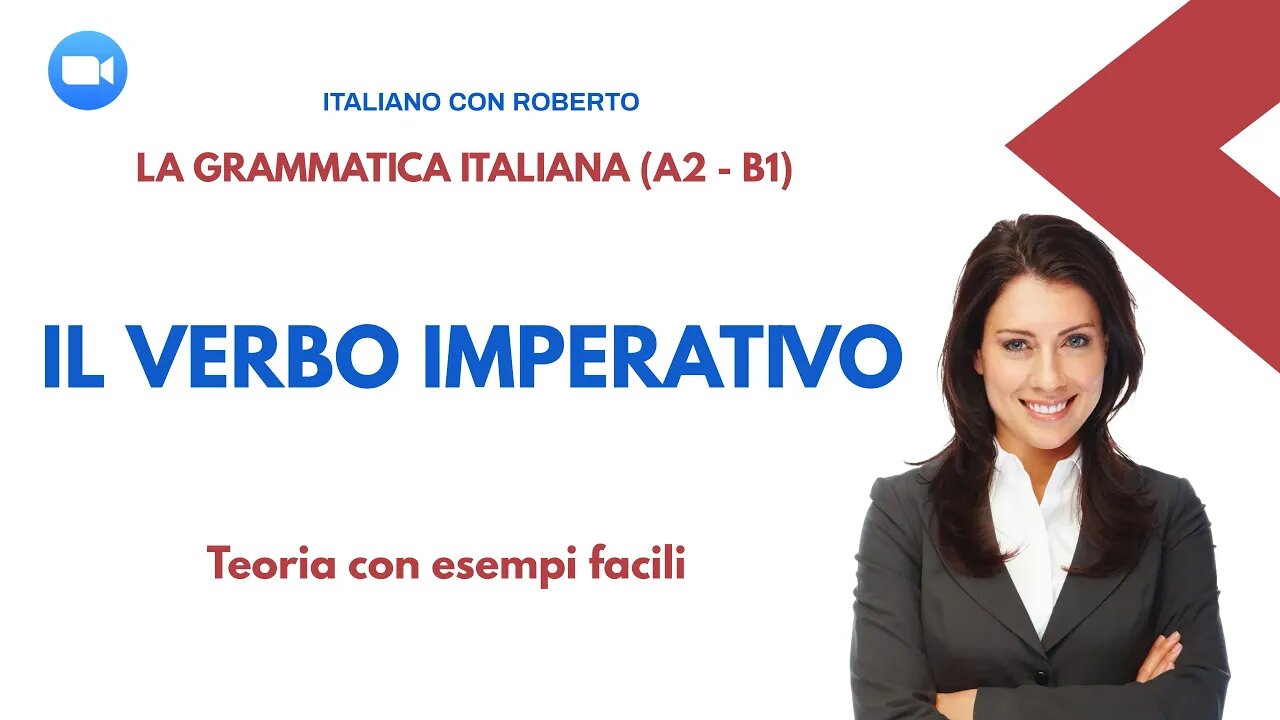Premium Only Content

"Become fluent in Italian: the imperative explained simply and clearly!"
ll modo imperativo nella lingua italiana.
L'imperativo è un modo verbale che viene utilizzato per esprimere un ordine, un invito, un consiglio o una richiesta. Si tratta di una forma verbale molto particolare, che si coniuga in modo diverso rispetto alle altre forme verbali. In italiano, l'imperativo si utilizza soprattutto per il singolare e il plurale della seconda persona, mentre nella terza persona si utilizza il congiuntivo presente.
Come si coniuga l'imperativo?
L'imperativo si coniuga in modo diverso a seconda del verbo e della persona a cui ci si rivolge. Nel caso della seconda persona singolare, si utilizza la forma base del verbo, mentre nel plurale si aggiunge la desinenza -ate per i verbi regolari, e la desinenza -ete per i verbi irregolari. Ad esempio, se volessimo dare l'ordine di "mangiare" a una persona singola, dovremmo dire "mangia!", mentre se volessimo rivolgerci a più persone dovremmo dire "mangiate!".
Per quanto riguarda i verbi irregolari, ci sono alcune forme particolari da memorizzare. Ad esempio, il verbo "fare" diventa "fa" nella seconda persona singolare e "fate" nella seconda persona plurale. Il verbo "dire" diventa "di'" nella seconda persona singolare e "dite" nella seconda persona plurale.
Inoltre, esistono alcune forme di imperativo irregolare che non seguono le regole di coniugazione standard. Ad esempio, il verbo "essere" ha una forma di imperativo irregolare: "sii" nella seconda persona singolare e "siate" nella seconda persona plurale.
Quando si usa l'imperativo?
L'imperativo viene utilizzato soprattutto per esprimere un ordine o un invito, ad esempio: "Vieni qui!", "Fai i compiti!", "Bevi un bicchiere d'acqua!". Tuttavia, l'imperativo può essere utilizzato anche per esprimere un consiglio o una raccomandazione, ad esempio: "Studia di più!", "Non preoccuparti!", "Mangia più verdura!".
È importante ricordare che l'imperativo va utilizzato con cautela, perché può risultare troppo diretto o addirittura offensivo in certe situazioni.
Esempi di imperativo nella vita quotidiana
• Vieni qui!
• Fai i compiti!
• Bevi un bicchiere d'acqua!
• Studia di più!
• Non preoccuparti!
• Mangia più verdura!
• Sii gentile!
• Siate pazienti!
• Ascoltami bene!
• Non ti preoccupare!
In sintesi, l'imperativo è un modo verbale molto utile per esprimere un ordine, un invito, un consiglio o una raccomandazione.
Coniughiamo all'imperativo i seguenti verbi: essere, avere, mangiare, leggere, dormire, bere, svegliarsi
• Essere: sii (tu), sia (lei/lui/formale), siamo (noi), siate (voi), siano (loro)
• Avere: abbi (tu), abbia (lei/lui/formale), abbiamo (noi), abbiate (voi), abbiano (loro)
• Mangiare: mangia (tu), mangi (lei/lui/formale), mangiamo (noi), mangiate (voi), mangino (loro)
• Leggere: leggi (tu), legga (lei/lui/formale), leggiamo (noi), leggete (voi), leggano (loro)
• Dormire: dormi (tu), dorma (lei/lui/formale), dormiamo (noi), dormite (voi), dormano (loro)
• Bere: bevi (tu), beva (lei/lui/formale), beviamo (noi), bevete (voi), bevano (loro)
• Svegliarsi: svegliati (tu), si svegli (lei/lui/formale), svegliamoci (noi), svegliatevi (voi), si sveglino (loro)
Se ti è piaciuto questo video iscriviti al mio canale, metti un like e condividilo con i tuoi amici sui social. Buon divertimento con la lingua italiana.
--
The imperative mode in the Italian language.
The imperative is a verbal mode that is used to express an order, an invitation, an advice or a request. It is a very particular verbal form, which is conjugated differently from other verbal forms. In Italian, the imperative is mainly used for the singular and plural of the second person, while the present subjunctive is used in the third person.
How is the imperative conjugated?
The imperative is conjugated differently depending on the verb and the person addressed. In the case of the second person singular, the basic form of the verb is used, while in the plural the ending -ate is added for regular verbs, and the ending -ete for irregular verbs. For example, if we wanted to give the order to "eat" to a single person, we would have to say "eat!", whereas if we wanted to address several people, we would have to say "eat!".
As far as irregular verbs are concerned, there are some particular forms to memorise. For example, the verb 'do' becomes 'does' in the second person singular and 'do' in the second person plural. The verb 'say' becomes 'say' in the second person singular and 'say' in the second person plural.
In addition, there are some irregular imperative forms that do not follow the standard conjugation rules. For example, the verb 'to be' has an irregular imperative form: 'be' in the second person singular and 'be' in the second person plural.
The imperative is mainly used to express an order or an invitation, e.g. "Come here!", "Do your homework!", "Have a glass of water!". However, the imperative can also be used to express advice or a recommendation, e.g.: "Study harder!", "Don't worry!", "Eat more vegetables!".
-
 LIVE
LIVE
Nikko Ortiz
1 hour agoPTSD Is Fun Sometimes | Rumble LIVE
75 watching -
 1:02:40
1:02:40
BonginoReport
3 hours agoA Florida Man Attempts a Jussie Smollett Hoax - Nightly Scroll with Hayley (Ep. 146)
102K54 -
 1:17:15
1:17:15
Playback Request Live
1 hour agoPRL EP 14 - EMO NIGHT 🖤
7471 -
 LIVE
LIVE
Blabs Games
4 hours agoWill We Find A Server? Star Wars Battlefront II | Noob Plays
101 watching -
 LIVE
LIVE
LFA TV
21 hours agoLIVE & BREAKING NEWS! | WEDNESDAY 10/1/25
725 watching -
 30:00
30:00
BEK TV
9 hours agoGUT HEALTH AND THE POWER OF KIMCHI WITH KIM BRIGHT ON TRENT ON THE LOOS
5.05K -
 LIVE
LIVE
LIVE WITH CHRIS'WORLD
3 hours agoLIVE WITH CHRIS’WORLD - Democrats SHUTDOWN The Government
79 watching -
 1:05:05
1:05:05
TheCrucible
4 hours agoThe Extravaganza! EP: 46 with Guest Co-Host: Elijah Schaffer (10/01/25)
82.4K18 -
 1:22:37
1:22:37
Kim Iversen
4 hours agoWas Tyler Robinson a Patsy? Deep Investigation Exposes the Plot Holes in the Kirk Shooting
69K84 -
 1:49:03
1:49:03
The Mike Schwartz Show
5 hours agoTHE MIKE SCHWARTZ SHOW Evening Edition 10-01-2025
17.3K3